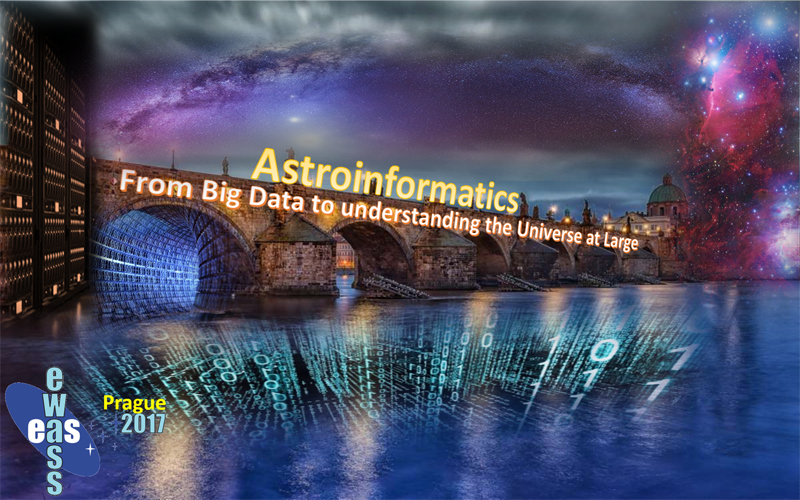|
Symposium S14
29 – 30 June 2017

News:
We have 63 abstracts registered. It will be an exciting meeting
In order to avoid conflict with this Symposium, talks in Special Section 16 - Developments and Practices in Astronomy Research Software - will take place on 28 June, allowing participants to follow both programs.
Aims and scope
Analysis and accurate interpretation of large and high dimensional data-sets is
becoming increasingly important throughout all scientific branches covering
scales ranging from the microscopic world of particle physics, to mega-scales
of cosmology. Astronomy has experienced a data deluge growing from Terabytes to
Petabytes. Besides the volume it is the complexity, and diversity, of the data
that bring interesting challenges that border the fields of mathematics,
statistics, computer science in general, and machine learning in particular. In
astronomy we can boast of datasets not only of billions of rows, but also
hundreds of columns. The extra features and measurements bring opportunities to
discover newer correlations but also increase computational complexities if not
handled properly. Astronomy often leads the way in posing problems and solving
them with its data that are heteroscedastic, sparse, and span orders of
magnitude in brightness over the entire electromagnetic range.
From current surveys like Kepler, Gaia, OGLE, CRTS, PTF, Pan-STARRS, to the era
of ZTF, LSST, SKA, BlackGem, Euclid, WFIRST, we will face newer challenges of
converting the huge datasets to actionable knowledge - choosing a few objects that need to be followed up right away (the real-time aspect), and
understanding entire families and sub-families that likely lurk in the dataset
(the archival aspect).
Time-Domain Astronomy has taken us from static snapshots to digital panoramic
cinematography of the universe. The resulting complex and rich data require
parallel and rapid computation before the most interesting phenomena fade to
oblivion. Rapid decisions and follow up are required to push the boundaries of
our understanding.
Owing to the differences in wavelengths/filters, aperture/depth, time-span, and
cadence from one survey to another, combining data is extremely non-trivial.
Yet, that is something that needs to be done if one is after results beyond
the low-hanging fruit. The complexity of incorporating ancillary data along
with diverse datasets implies that one needs to combine various strategies and
also look closely at other fields and borrow methods that may have been used in
parallel situations.
In the US there are many Astroinformatics initiatives underway through the
American Astronomical Society, American Statistical Association, LSST and SAMSI
through focused groups and meetings. COST Big Sky Earth and the
Cosmostatistics Initiative (COIN) are in a similar position for Europe. Through
this symposium we hope to bring together many experts to better integrate
astroinformatics and standardization in all fields of astronomy, in order to
convert data to knowledge.
We aim to cover aspects of Supervised, Semi-supervised, and Unsupervised
learning, Convolutional Networks, visualization, and updates on various surveys
through review talks, invited talks, contributed talks, panel discussions and
posters with 1-minute lightning talks. The format will encourage thinking and
interaction among participants well after the Symposium.
To promote its interdisciplinary character the symposium is organised in close
collaboration with Faculty of Information Technology of the Czech Technical
University in Prague, Faculty of Information Technology of Brno University of
Technology and with support of European COST Action TD1403 Big Sky Earth, which
aims at identifying the problems and methodologies common to both astronomy
and Earth observation in the Big Data era. As no Astroinformatics session was
held during past EWASS meetings, this symposium will be a great way to
introduce various aspects of Data Science to the wider EWASS community.
Programme
- Finding hidden correlations in the complex astronomical Big Data
- Challenges of spatial queries in peta-scale surveys
- Massively parallel data mining in huge distributed databases
- Scientific visualisation of complex many-dimensional data sets
- Standardization of meta-data for better science
- Advanced statistical inference in cosmology
- Real time transient detection and classification
- Applications of machine learning for source classification and clustering
- Deep neural networks for feature extraction and image classification
- Active learning and Domain Adaptation
- Interdisciplinary panel discussions
Invited speakers
- Mark Allen, Strasbourg astronomical Data Center, FR
- Laurent Eyer, University of Geneva , CH
- Emille E. O. Ishida, University Blaise Pascal, Clermont-Ferrand, FR
- Darko Jevremovic, Astronomical observatory Belgrade, RS
- Johan Knapen, Instituto de Astrofísica de Canarias (IAC), Tenerife, ES
- Giuseppe Longo, University of Federico II, Naples, IT
- Ashish Mahabal, Center for Data-Driven Discovery, Caltech, Pasadena, USA
- Agnieszka Pollo, National Center for Nuclear Research Warsaw+University Krakow, PL
- Kai Lars Polsterer, Heidelberg Institute for Theoretical Studies, DE
- Enrique Solano, Centro de Astrobiologia, INTA-CSIC, Villafranca, ES
- Aleksandra Solarz, National Center for Nuclear Research, Warsaw, PL
- Edwin. A. Valentijn, University of Groningen, NL
- Dejan Vinkovic, Science and Society Synergy Institute+Hipersfera Ltd., HR
- Lukasz Wyrzykowski, University of Warsaw, PL
- Karine Zeitouni, University of Versailles, FR
Scientific organisers
- Petr Škoda (Chair), Astronomical Institute of the Czech Academy of Sciences, Ondřejov, CZ
- Massimo Brescia, Astronomical Observatory of Capodimonte, Naples, IT
- Maria Gritsevich, Finnish Geospatial Research Institute, Helsinki, FI
- Emille Ishida, Blaise Pascal University, Clermont-Ferrand, FR
- Johan Knapen, Instituto de Astrofísica de Canarias , Tenerife, ES
- Ashish Mahabal, Caltech Center for Data-Driven Discovery, Pasadena, USA
- Agnieszka Pollo, National Center for Nuclear Research Warsaw, PL
- Kai Lars Polsterer, Heidelberg Institute for Theoretical Studies, DE
- Pavel Smrž ,Faculty of Information Technology, Brno University of Technology, CZ
- Rafael de Souza, University Sao Paulo, BR
- Felix Stoehr, ESO ALMA, Garching, DE
- Karine Zeitouni, University of Versailles, FR
Contact
|